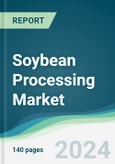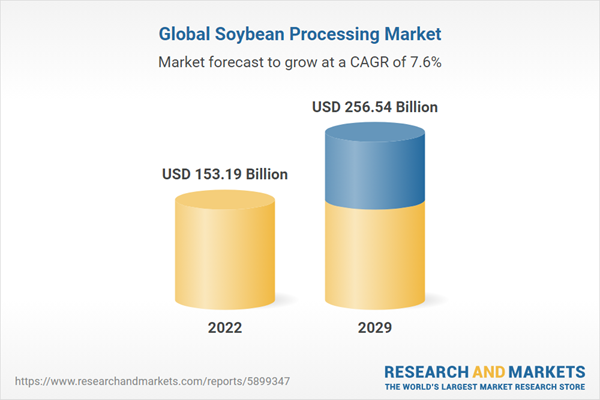Soybean Processing Market is expected to grow at a CAGR of 7.64% from a market size of US$153.19 billion in 2022 to reach US$256.54 billion in 2029.
The growing consumer demand for soy-based goods and the emphasis on health and wellness are driving the global market for soybean processing. The rise of the market is facilitated by the growth of the livestock feed sector and the use of soybean oil in the manufacturing of biofuel. Government regulations, technological developments, and the dynamics of international trade all play crucial roles. A greater focus on environmental sustainability and weather patterns that impact agricultural yields add further intricacy to the market's evolution.As per the Government of India, Madhya Pradesh generates 54% of India's total soy production. Madhya Pradesh's western and northwestern regions are important hubs to produce soy. The number of soy processing industries in the state has expanded due to the state's good and significant soybean production. It is well known for being a filling, high-protein dish, and its oil is the best vegetable oil on the market.
Players in the soybean processing industry use tactics such as product portfolio diversification, vertical integration, sustainable practices, and international expansion to fulfill growing demand, boost competitiveness, and adjust to changing consumer tastes. Their success in this fast-paced market is also a result of their efforts in R&D, cost optimization, and open consumer interaction
Market Drivers:
Increasing demand for soy products
Globally, the soybean processing market experiences a significant boost due to the rising demand for soy-based products, driving increased production and processing activities. Manufacturers are expanding their operations to meet the growing market needs, fueled by heightened consumer awareness of the health benefits associated with soy-derived goods.This surge in demand typically leads to a greater utilization of soybeans across various product lines such as lecithin, oil, and protein. With heightened throughput and output within the soybean processing sector, there's a notable uptick in investment and economic growth. Overall, the market for soybean processing is witnessing steady growth, largely attributed to consumer preferences favoring soy products.
In 2023, U.S. soybean exports reached a total value of $27.94 billion, further underlining the robustness of the market. Opportunities for promoting soy foods continue to evolve, particularly with the introduction of innovative food service offerings.
Products like silken tofu puree enable easy recipe modifications, providing restaurants with flexibility without the need to introduce entirely new menu items. Instead, these tofu-based products can seamlessly adapt existing dessert, beverage, soup, and sauce recipes, either complementing or substituting dairy ingredients. The soyfoods industry stands at the forefront of meeting evolving customer expectations, driven by its capacity to innovate and introduce new products.
Market Restraint:
Regulations as market restraint
GM soybeans are widely utilized in certain nations, notably the US; however, they encounter opposition elsewhere due to apprehensions regarding safety and environmental repercussions. Strict regulatory frameworks and consumer apprehensions surrounding genetically modified organisms (GMOs) can constrain the market for processed soybean goods in specific geographic areas.North America is anticipated to hold a significant share of the soybean processing market.
North America, especially the United States, stands out as a primary producer of soybeans, playing a significant role in the global supply chain. The abundance of this raw material in the region facilitates economically feasible processing operations.Within North America, there exists a substantial demand for soybean products, including soybean oil utilized in both culinary and industrial applications, as well as soybean meal essential for animal feed. This internal demand serves as a key driver for the soybean processing industry in the region.
Market Developments:
- November 2023- Cargill's integrated soybean crush and refined oils facility in Sidney, Ohio, underwent a major expansion and modernization project. Cargill is now able to better serve farmers and fulfill the increasing demand for soy products in the food, feed, and renewable fuel industries owing to the improved facility that went online in September.
- November 2023- ADM and Marathon Petroleum Corp. commemorated the opening of their joint venture soybean processing complex, Green Bison Soy Processing. The first dedicated soybean processing complex in North Dakota, the Green Bison facility in Spiritwood, is a significant step in satisfying the growing demand for renewable fuels, in this instance renewable green diesel.
- October 2023- The building of a soybean processing facility in Upper Sandusky, Ohio, US, with integrated crushing, vegetable oil refining, lecithin synthesis, and packaging capabilities, was announced by Louis Dreyfus Company (LDC). The new facility, whose construction is anticipated to start in early 2024, will employ more than 100 people and have an annual capacity of 1,500,000 MT for soy crushing, 320,000 MT to produce edible (RBD) soybean oil, and 7,500 MT for lecithin production.
Market Segmentation:
By Product
- Oil
- Meal
- Others
By Application
- Animal Feed
- Food and Beverages
- Personal Care
- Dietary Supplements
- Pharmaceuticals
- Others
By Geography
- North America
- USA
- Canada
- Mexico
- South America
- Brazil
- Argentina
- Others
- Europe
- Germany
- France
- UK
- Spain
- Others
- Middle East and Africa
- Saudi Arabia
- UAE
- Israel
- Others
- Asia Pacific
- China
- Japan
- India
- South Korea
- Indonesia
- Thailand
- Others
Table of Contents
Companies Mentioned
- ADM
- CHS Inc.
- Louis Dreyfus Company
- CGB Enterprises
- Ag Processing
- Incobrasa Industries Limited
- Yemmak
- Farmet
Table Information
| Report Attribute | Details |
|---|---|
| No. of Pages | 140 |
| Published | March 2024 |
| Forecast Period | 2022 - 2029 |
| Estimated Market Value ( USD | $ 153.19 Billion |
| Forecasted Market Value ( USD | $ 256.54 Billion |
| Compound Annual Growth Rate | 7.6% |
| Regions Covered | Global |
| No. of Companies Mentioned | 8 |









